
It’s a great time to be alive for fans of the immortal proto-punk wizards, the Stooges. Jim Jarmusch’s documentary on the band, Gimme Danger, hits theaters this week, and TOTAL CHAOS: The Story of the Stooges comes out in mid-November on Third Man Books. I can tell you, based on my preview, TOTAL CHAOS is phenomenal—a must-have for all fans of the group. The book is constructed around in-depth interviews with frontman Iggy Pop, and a slew of of rarely seen memorabilia, which together tell the story of the Stooges. Those praising the band via their own contributing essays include Johnny Marr, Joan Jett, and Jack White, as well as noted scribes Johan Kugelberg and Jon Savage.
We have exclusive excerpts for you from TOTAL CHAOS. The text and images revolve around the seminal Stooges LP Fun House, one of the greatest albums of the entire rock era. In the first interview excerpt, Iggy talks about the stage name he has used since the time of Fun House. The moniker appeared for first time within the album’s credits, the inspiration coming from a friend of Stooges bandmates Ron Asheton and Dave Alexander.
Jim P-o-p-p was one of the delinquent friends of Ron and Dave and one of the people that hung out with that group. He had sniffed too much glue and lost a lot of his hair early. And he just had such a great last name that one day I was in the Student Union [at the University of Michigan] sneaking some coffee and I thought about what a great name he had. He was laying there sleeping in one of the booths. Townies would go over there to get cheap food. Sneak into the Student Union and just hang. And later I thought, “Well, I don’t know. I wanna be…” It was really even before the first album came out I started calling myself Iggy Pop, and then they [the record company] just said Iggy Stooge. So yeah, I nicked it from Jim Popp.

‘Fun House’ promo poster (Johan Kugelberg collection)
Writing the material for Fun House:
The groups we liked were starting to do really sophisticated things. At the same time, whether it was my personality or the fact that he was now getting laid regularly, or a little bit of the fact that everybody has their own rate of production and their own event horizon and Ron’s was slow; somehow from my point of view, Ron went into a tunnel at that point and I could not break him out. He came up with a few ideas that I thought sounded like our first album but not quite as good, and the one of them that was the best was “TV Eye.” So I got him to try an arrangement. He just had it as sort of a chord thing. I said, “How about if we get to that point, but start it out single string like a Booker T thing.” He knew that reference and he tried it, but to do that, I had to camp outside his door day and night. Hassle him.
So most of the rest of the record, I wrote on a Mosrite guitar with a fifty watt Marshall amp up in my room and only Ron could have played it so wonderfully, but most of that, I wrote. Now Ron tells me later, he said that Dave did the riffs to “Dirt” and “Fun House.” I would say I hope so, but I don’t remember it that way. But without that one “T.V. Eye” riff and without hearing how great it sounded when he played it, the single string with the resonance and then build up, I would have had nothing to build on, so he was the bedrock of that album.
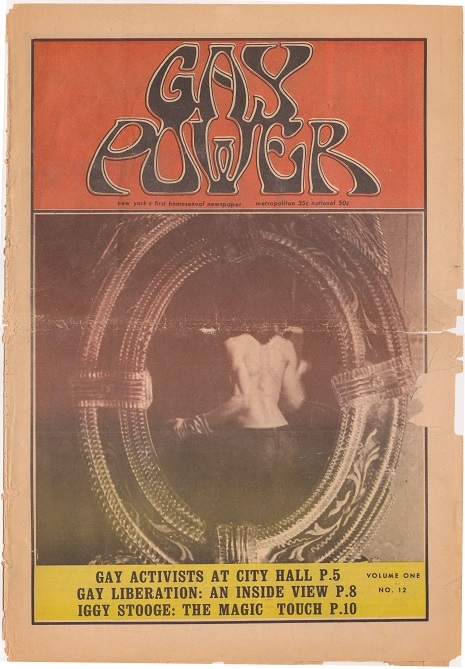
Iggy on the cover of ‘Gay Power: New York’s First Homosexual Newspaper,’ 1970 (Jeff Gold collection)
When asked if it was his idea to record Fun House live in the studio:
I believe so. We came out and we were gonna do this our way and Don [Gallucci, the producer,] went along with it but we compromised in that they, for my vocal I believe they ran a double feed. To the board and to the other and mixed it. The engineer was a charming, cultured British individual. I’d never met anybody like this and I was instantly charmed and reassured and I trusted him and I believed in him. His name was Brian Ross-Myring and I didn’t know he did Barbra Streisand apparently, but he had an unflappable quality.
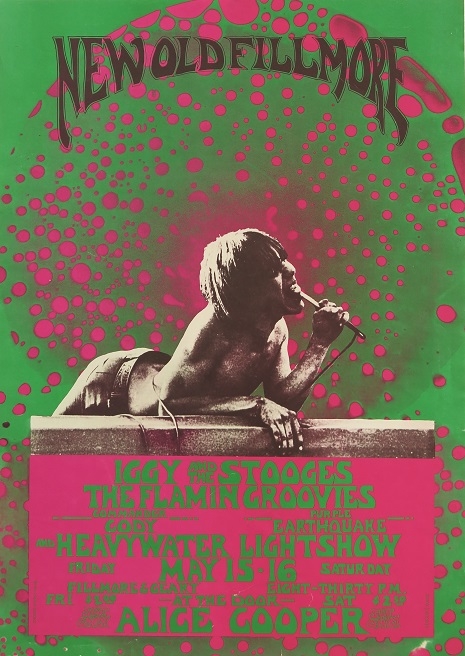
The Stooges perform in San Francisco for the first time, 1970 (Jeff Gold Collection)
I just remember that in San Francisco some of the Cockettes
were in the front row and I was psychedelicized that night. More than several of the Cockettes were dressed up like Carmen Miranda gone wild and I was like, “what the hell is this”—and I loved it—“this is so cool and bananas and oranges and you know calico scarves and the whole thing.” The other big thing I remember about it was, when we were—it was either during sound check or maybe somewhere during the gig when we weren’t playing—this strange kind of cocky hippie with granny glasses approaches me and he said, “Hi, I’m Owsley Stanley,” and he was real pleased, he was already pleased with himself, and he made some sort of comments, I can’t remember what, but I did meet [LSD kingpin] Owsley and talked with him a little bit. I mean that’s what you do if you go to San Francisco in 1970, you meet the Cockettes and at least one member of the Psychedelic Set.
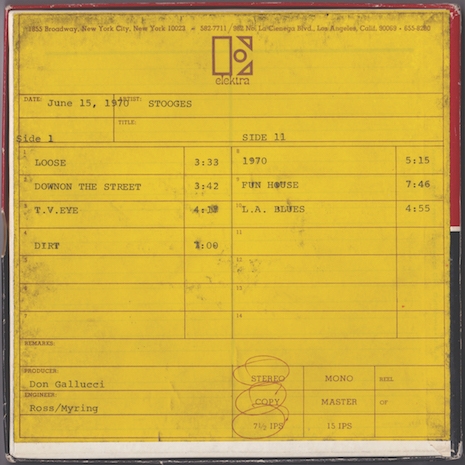
The ‘Fun House’ master tape box, with the track sequence the band wanted, which was altered slightly by Elektra (Jeff Gold Collection)
On audiences:
It was always better when you had some activity in front, always. It’s really hard without that, and sometimes we’d get, it ranged from violent activity to people thinking like “hey we get the joke” and come in with peanut butter or sometimes we’d have a lot of just female rock action—it just would depend really where we were. The one thing that always gave me heart was I was very aware that we were the only group I knew of, or entity, that had absolute—I never saw any audience movement while we played for the first, I’d say ’68, ’69 and ’70, nobody said, “Oh I’m gonna go check out the t-shirt stand,” or “I’m gonna walk around and see if I can pick up some chicks or go get a whatever.” No, uh-uh, everybody stayed in one place. So I knew we were onto something, you know?

Iggy in the audience during a gig at Uganos, New York City, August 1970
(Photo: Dustin Pittman; Jeff Gold Collection)
TOTAL CHAOS author Jeff Gold first saw the Stooges in the ‘70s, and has been a fan ever since. He provided much of the memorabilia pictured in the book, and conducted the Iggy interviews that appear in it, along with Johan Kugelberg. He’s worked at various record labels, including A&M when Iggy was signed with the company in the mid-to-late ‘80’s. I asked Jeff a few questions via email.
I’ve only met a few people who can say they saw the Stooges back in the day. You saw them in 1973. What was that like?
Jeff Gold: It was the strangest “show” I’d ever seen. I’d heard of them, but didn’t really know who they were. I was a huge David Bowie fan and the fact that he’d gotten his management to sign them, and mixed the album was enough to get me to spend $2.50 to see them at the Whisky in Los Angeles. The whole show lasted maybe half an hour. I’d heard Iggy was a wild man who cut himself with glass, so I was prepared for something unusual. He was wearing only blue metallic bikini underwear—nothing else—which at some point he threaded through the microphone stand, humping it. He was definitely under the influence of something, and spent part of the show wailing about butt-fuckers in Hollywood, and after about 30 minutes, he started falling down and Ron Asheton, I think, had to help him off stage. It was total chaos, which is the title of the book, but completely compelling chaos, and unforgettable.
Being such a fan, I imagine it was a strange experience when you found yourself working with Iggy at A&M.
Jeff Gold: By that time I’d worked with many famous musicians, but Iggy was someone I was a big fan of personally, which wasn’t always the case. I’d seen him on the 1977 tour for The Idiot, with Bowie on keyboards, which was a much more “professional” affair. But still you never know what someone will be like offstage, so I was both excited and a bit wary. But Iggy was and is the greatest. He was friendly, had lots of good ideas about album covers, videos, and marketing, and was a real pleasure to deal with. I remember taking him out to lunch early on, and being sort of blown away—I’m having lunch with Iggy Pop!

Iggy, 1970 (Photo: Robert Matheu)
How long have you been collecting Stooges memorabilia? What do you consider to be some of the more interesting items in your collection?
Jeff Gold: I began collecting records and memorabilia in the early ‘70’s and when I saw interesting Stooges stuff, I’d buy it. I left Warner Bros. in 1998, and got back into buying and selling music stuff full time, and that coincided with the dawn of eBay, so there was much more of it on the market, and I took advantage of that. As for the Stooges things I find most interesting, I bought copies of all of their original contracts from Danny Fields, who signed and later managed them. After my years working for record companies, it was wild to see what a late ‘60’s record contract looked like, and that they were signed for only a $5,000 advance. Iggy didn’t have these, and was very appreciative when I gave copies to his lawyer. Hidden amongst them was a letter from Elektra to Danny Fields attempting to pick up their option on Iggy as a solo artist, after they’d dropped the Stooges. Iggy never knew they wanted to sign him as a solo act, and it blew his mind to find out about it all those years later.
Tell us about the process of sitting down with Iggy to work on what would become TOTAL CHAOS.
Jeff Gold: Iggy has a fantastic memory and is a wonderful storyteller. My friend Johan Kugelberg and I interviewed him in his back yard in Miami, armed with 100 printouts of rare Stooges memorabilia from our collections—photographs, posters & handbills, documents, and a 21 page list of questions. We were wholly unprepared for how much he remembered and how much he had to say. I think Ron and Scott Asheton’s passing had Iggy in a reflective mood. There were times I actually had to cut him off and move on to the next question—which I really didn’t want to do, but we had a limited time and I wanted to get through it all. I’ve met many rock stars in my lifetime, but none with a better recall than Iggy, and the interviews for this book were a high point of my career.
In 2003, you saw the first Stooges reunion show. What was that experience like for you?
Jeff Gold: Johan and I went together to see the first Stooges reunion show at Coachella. I had lunch with Iggy’s longtime manager, the late great Art Collins a few days before, and he told me how well the rehearsals were going. But we were wholly unprepared for how incredible they were, and how emotional an experience it was for the crowd and the band. I remember saying to Johan during the show “this is probably the first show they ever played straight!” I said this to Iggy years later and he said it could have been. They were just fantastic and feeding off the crowd’s energy. It was so amazing—they’d broken up 29 years before, to almost total indifference, drug addicted and broke. And here they were playing their first gig in all that time to 30,000 cheering people. And they were incredible!
For years it felt like Fun House was the dark horse in their catalog, but now it’s often viewed as the best Stooges record. What do you think caused this change in assessment? What do you think of the album?
Jeff Gold: Fun House is and has always been my favorite Stooges album, because it takes the primal sounds of their first album and gets more experimental and out there. I know a lot of younger people like Raw Power more, and I’ve got a theory about that. I worked in a record store, Rhino Records in L.A., during the ‘70’s. At that point the only Stooges albums you could find were Raw Power and Metallic K.O. Those were the only two in print. So for a lot of kids those were the Stooges albums they knew, and only much later did the first two get reissued domestically. During the ‘80’s you could intermittently get them as imports, but they weren’t generally available. So I think people preferred the ones they fell in love with first, and listened to over and over. That’s my theory anyway.
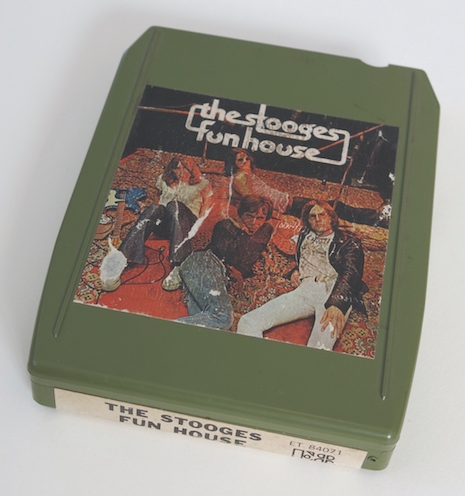
‘Fun House’ 8-track (Mark Arevalo collection)
TOTAL CHAOS: The Story of the Stooges is due November 15th. Pre-order it on Amazon. Also on November 15th, Jeff Gold’s previous publication, 101 Essential Rock Records is coming out on paperback with additional content. The book is a tribute to vinyl, and includes contributions from such towering figures as Iggy and David Bowie. Another title, God Save Sex Pistols, authored by the aforementioned Johan Kugelberg and Jon Savage, recently came out. From what I’ve seen, it looks like a pretty amazing book, and like TOTAL CHAOS, it’s filled with rare photos and ephemera. Check it out here.
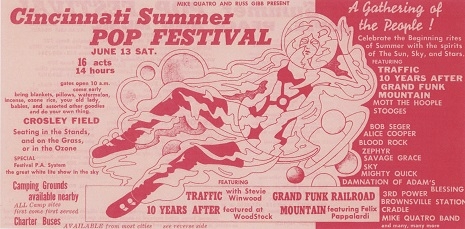
The Stooges’ performance at this festival would prove to be legendary (Michael Storeim/Classic Posters collection)
And just because it never gets old, we’ll leave you with the Stooges’ famed 1970 appearance at the Cincinnati Summer Pop Festival. Partial versions of two songs—“T.V. Eye” and “1970”—from Fun House (which hadn’t been released yet), aired on the network television special Midsummer Rock. If you are one of the few reading this that hasn’t seen the footage, boy are you in for a treat. It’s safe to say that just about everyone who witnessed the performance—in the crowd and at home—had never seen anything like it.